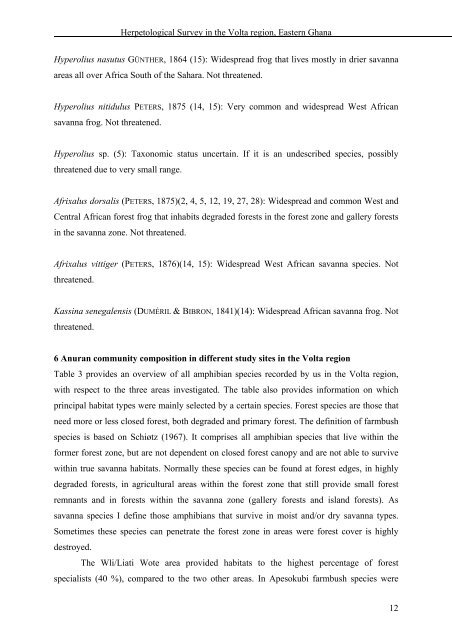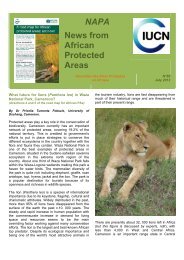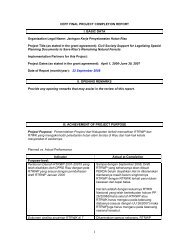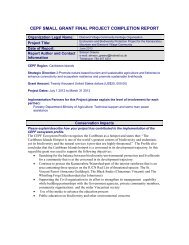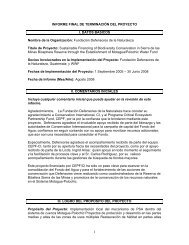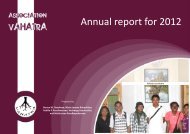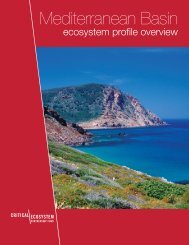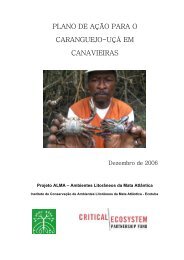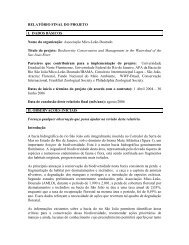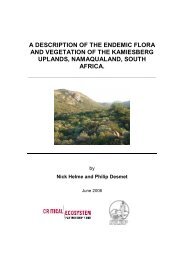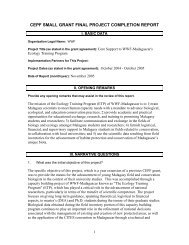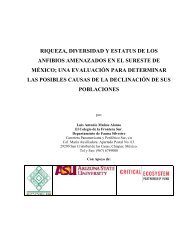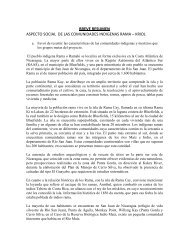Herpetological survey in the Volta region, Eastern Ghana - Critical ...
Herpetological survey in the Volta region, Eastern Ghana - Critical ...
Herpetological survey in the Volta region, Eastern Ghana - Critical ...
You also want an ePaper? Increase the reach of your titles
YUMPU automatically turns print PDFs into web optimized ePapers that Google loves.
<strong>Herpetological</strong> Survey <strong>in</strong> <strong>the</strong> <strong>Volta</strong> <strong>region</strong>, <strong>Eastern</strong> <strong>Ghana</strong><br />
Hyperolius nasutus GÜNTHER, 1864 (15): Widespread frog that lives mostly <strong>in</strong> drier savanna<br />
areas all over Africa South of <strong>the</strong> Sahara. Not threatened.<br />
Hyperolius nitidulus PETERS, 1875 (14, 15): Very common and widespread West African<br />
savanna frog. Not threatened.<br />
Hyperolius sp. (5): Taxonomic status uncerta<strong>in</strong>. If it is an undescribed species, possibly<br />
threatened due to very small range.<br />
Afrixalus dorsalis (PETERS, 1875)(2, 4, 5, 12, 19, 27, 28): Widespread and common West and<br />
Central African forest frog that <strong>in</strong>habits degraded forests <strong>in</strong> <strong>the</strong> forest zone and gallery forests<br />
<strong>in</strong> <strong>the</strong> savanna zone. Not threatened.<br />
Afrixalus vittiger (PETERS, 1876)(14, 15): Widespread West African savanna species. Not<br />
threatened.<br />
Kass<strong>in</strong>a senegalensis (DUMÉRIL & BIBRON, 1841)(14): Widespread African savanna frog. Not<br />
threatened.<br />
6 Anuran community composition <strong>in</strong> different study sites <strong>in</strong> <strong>the</strong> <strong>Volta</strong> <strong>region</strong><br />
Table 3 provides an overview of all amphibian species recorded by us <strong>in</strong> <strong>the</strong> <strong>Volta</strong> <strong>region</strong>,<br />
with respect to <strong>the</strong> three areas <strong>in</strong>vestigated. The table also provides <strong>in</strong>formation on which<br />
pr<strong>in</strong>cipal habitat types were ma<strong>in</strong>ly selected by a certa<strong>in</strong> species. Forest species are those that<br />
need more or less closed forest, both degraded and primary forest. The def<strong>in</strong>ition of farmbush<br />
species is based on Schiøtz (1967). It comprises all amphibian species that live with<strong>in</strong> <strong>the</strong><br />
former forest zone, but are not dependent on closed forest canopy and are not able to survive<br />
with<strong>in</strong> true savanna habitats. Normally <strong>the</strong>se species can be found at forest edges, <strong>in</strong> highly<br />
degraded forests, <strong>in</strong> agricultural areas with<strong>in</strong> <strong>the</strong> forest zone that still provide small forest<br />
remnants and <strong>in</strong> forests with<strong>in</strong> <strong>the</strong> savanna zone (gallery forests and island forests). As<br />
savanna species I def<strong>in</strong>e those amphibians that survive <strong>in</strong> moist and/or dry savanna types.<br />
Sometimes <strong>the</strong>se species can penetrate <strong>the</strong> forest zone <strong>in</strong> areas were forest cover is highly<br />
destroyed.<br />
The Wli/Liati Wote area provided habitats to <strong>the</strong> highest percentage of forest<br />
specialists (40 %), compared to <strong>the</strong> two o<strong>the</strong>r areas. In Apesokubi farmbush species were<br />
12


